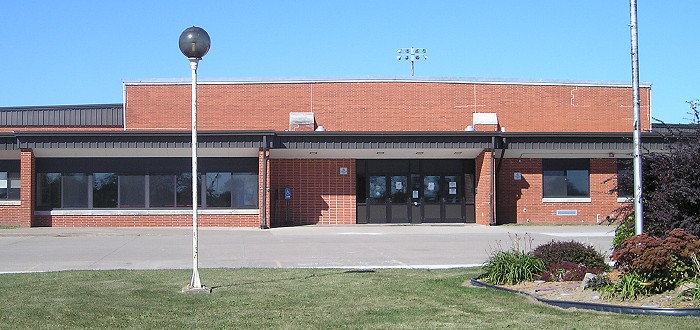
October 3, 2015: Harmony High School, a one-story building at the intersection of J46 and W46, will become the sole building for Harmony this fall, with all elementary students relocating here from Bonaparte. Junior high and high school students will go to Van Buren High School in Keosauqua, leaving one high school in the county from three in 2001.
In the early 2000s, Benton Community High School in Van Horne covered the eighth-largest area of any school district in Iowa. A student generation later, it won’t even rank in the top 25.
This fall there will be 13 places in Iowa where one high school serves an area larger than 400 square miles. Combined, they cover one-tenth of the land in the state. The 32 high schools overall that cover areas greater than 300 square miles will account for 22.2% of Iowa’s area.
The newest additions to the jumbo list come from southern and northwestern Iowa. This fall, the Harmony district will send grades 7-12 to Van Buren in Keosauqua, and Marcus-Meriden-Cleghorn and Remsen-Union will start whole-grade sharing.
Laurens-Marathon, whose inability to field a girls’ basketball team a year and a half ago kicked off a New York Times story about the power shift to urban areas in Iowa, still has a high school but as of last year is in partial sharing with Pocahontas Area. LM freshmen and sophomores spend a quarter of their day 15 miles away at “Poky”; juniors and seniors spend half. In those periods, Pocahontas Area is supporting nearly 550 square miles’ worth of high school kids, just like Algona. This fall Ar-We-Va, which brought together all its students in the Westside building four years ago, is going to start partial-day sharing with Carroll. (These are similar to what Paton-Churdan has done with Greene County, formerly Jefferson-Scranton, since 2004.)
This series has been all about numbers, but of course the numbers are only part of it. A story about a rural town losing its high school often is also a story about a town’s largest or second-largest employer shedding up to half its workforce. Then, when the junior high or an elementary is closed and students are condensed into one location, that town loses one of its largest employers. Students who once could walk to school now either drive or have to wait for the bus. There are longer drive times for sports teams (and the athletes’ parents). The growing distances can mean that maybe someone in the community who doesn’t have children/grandchildren directly involved decides it’s not worth driving to see an event when it’s 10 degrees outside. It’s created a paradox: Larger areas are bound together, yet tight-knit communities face a Great Unraveling.
The rapid increase in large-area high schools and, in course, large-area school districts should be sounding alarms about both depopulation and school funding. (Hmm… what are the rules on artificial noisemakers by groups at the state Capitol? Would an army of clanging cowbells serve to make a point? Because you always need more cowbell.) It also has effects on the growing urban-rural split in Iowa, because the voices for rural schools will continue to dwindle. One can envision some time in the future that a metro-area legislator will float a bill to force consolidations, and there won’t be enough people on the other side to stop it.
Next week: A look at enrollment.
